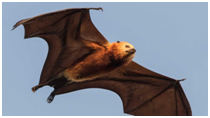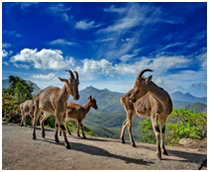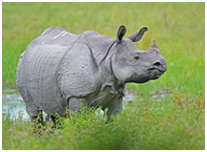|
Chocolate albatross (Appias lyncida)

|
- The chocolate albatross is found in India, China, Sri Lanka, Myanmar, Malaysia, Indonesia, Philippines, Thailand, Laos, Indochina, Taiwan, and possibly South China.
- In India, this butterfly ranges across south India, Nicobar Islands, Sikkim to Assam, and onto Myanmar.
- In South India the chocolate albatross is to be found along the foot of the Western Ghats. It is found throughout the year in the Nilgiris where it is locally common.
- In the northern parts of peninsular India it extends into Orissa and north up to Lucknow.
|
|
Flying Fox (Pteropus)

|
- It belongs to a genus of megabats which are among the largest bats in the world.
- They are commonly known as ‘fruit bats’ or ‘flying foxes’, among other colloquial names.
- They live in South Asia, Southeast Asia, Australia, East Africa, and some oceanic islands in the Indian and Pacific Oceans.
- There are about 65 bat species found on tropical islands from Madagascar to Australia and Indonesia and in mainland Asia. Most species are primarily nocturnal.
|
|
TN Launches Project To Protect Nilgiri Tahr

|
In India's first-of-its-kind initiative, Tamil Nadu launched the 'Nilgiri Tahr project' to restore the state animal's original habitat and stabilising its population.
- Duration: Five-year
- The initiative was devised in line with Project Tiger and Project Elephant.
- About the Species:
- Nilgiri Tahr is an endangered wild goat species.
- Local name: Varaiaadu
- Habitat: The species was earlier found along the entire stretch of the Western Ghats, but they now remain restricted to small fragmented pockets in Tamil Nadu and Kerala.- WWF data (2015)
- The Eravikulam National Park in Anamalai hills, Kerala, is home to the largest population of the Nilgiri Tahr.
- Protection Status: They are protected under Schedule-I of the Wildlife (Protection) Act of India, 1972 and considered endangered by the IUCN.
|
|
No rhinos poached in Assam in 2022

|
The Chief Minister of Assam has informed that no rhinos were poached in the state in 2022.
About Indian Rhinos :
- The Indian rhinoceros (Rhinoceros unicornis) is found only in the Brahmaputra valley, parts of North Bengal, and parts of southern Nepal.
- It has a single black horn that can grow up to 60 cm, and a tough, grey-brown hide with skin folds, which gives the animal its characteristic armour-plated look.
- Protection status:
- IUCN Red list: The Indian rhino is listed as ‘vulnerable’ (it was earlier placed in the endangered category).
- The WWF says the recovery of the greater one-horned rhino is among the greatest conservation success stories in Asia.
- Why they are poached?
- Rhino horn is used in traditional Chinese medicine to cure a range of ailments.
- It also used to treat cancer.
- In Vietnam, a rhino horn is considered a status symbol.
- Conservation efforts:
- In 2019, the Assam government constituted a Special Rhino Protection Force to keep a check on rhino poaching and related activities at Kaziranga National Park (KNP).
- On every September 22, World Rhino Day is celebrated.
|








